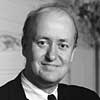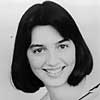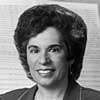The Orchestra in Contemporary American Musical Life
 Frank J. Oteri Photo by Melissa Richard |
Is the orchestra a viable contemporary American institution? That’s a question that’s been on a lot of people’s minds both within and outside the orchestral music community as well as within the new music community which all too frequently has been treated like an opposition political party.
There are two schools of thought about the function that the orchestra should serve in a community. One camp contends that the orchestra is a sonic museum that preserves the timeless classics of our musical heritage, presenting them again and again in a live setting so new audiences can discover them and that audiences already familiar with them can gain new insights with each rehearing. The other camp contends that the orchestra must take a pro-active role in our society, performing and commissioning new works, doing extensive community outreach and being at the cutting edge of new technologies. Opponents of the museum approach say the orchestra is outmoded and irrelevant to contemporary society, a throwback to the old boy system, a torchbearer of “Dead White European Male” culture to the exclusion of the achievements of all other people. Opponents of the pro-active model contend that orchestras should do what they do best, which is to play great music, and might rightly point to such horrific models as the expunging of “degenerate art” in Nazi regime’s rewriting of the canon or the Cultural Revolution in the People’s Republic of China as proof that dictating artistic choices based on so-called “politically correct” grounds yields a tepidly satisfying aesthetic experience at best.
Much can be gained by looking at both sides of this argument and seeing how to preserve the great legacy of orchestral music of the past while at the same time building a new and vibrant orchestral experience which may indeed be tomorrow’s great legacy. We invited you to take a stand in this great debate in our interactive forum
This month, we have chosen to enter the NewMusicBoxing ring with four members of the staff of the Philadelphia Orchestra: artistic administrator Simon Woods, president Joseph H. Kluger, marketing director Ed Cambron and assistant communications director Brian Atwood. The Philadelphia Orchestra, considered by most music aficionados to be one of our greatest orchestras but rarely perceived of as a maverick in the orchestral music community, has taken an unusual step for their 1999-2000 season. Every work played in a subscription concert this season was composed in the 20th century. And while contemporary music fans may balk at a “20th century” season filled with Ravel and Rachmaninoff but missing Carter and Messiaen, it’s a more-than-welcome change of pace from the bottomless sea of Basically Beethoven, Totally Tchaikovsky or Masochistically Mozart. Andrew Druckenbrod’s hyper-history surveys the commissioning and premiering legacies of 18 additional American orchestras in an attempt to determine how American and contemporary contemporary American orchestras actually are. We have supplemented both the Philadelphia Orchestra interview and the orchestral hyper-history with a variety of documents ranging from press releases to lists of commissions and premieres spanning the entire century to try to paint as complete a picture as we possibly can. In fact, we have also supplemented our leading news story this month — an announcement of two premieres by the New York Philharmonic financed by the Walt Disney Company — with the complete transcript of the press conference led by Disney CEO Michael Eisner.
We decided to contrast this serious probing by having a little fun with people’s memories of premieres. We’ve asked composers John Corigliano and David Del Tredici, flutist Laurel Ann Maurer, and former music critic Tim Page to tell us their best and worst memories of premieres from the varying viewpoints of composer, performer and audience member. Unfortunately, orchestral music was not the focus of a large percent of either our listings of concerts featuring American repertoire or our online exploration center for new recordings of American music. But there are many fascinating items to be found there nonetheless.
We hope that through presenting all this material we can inspire further dialog and help energize the playing field of American orchestras, a community which, in size and geographic distribution, is on par with America’s other great team sports and which, if the conditions are right, can create an evening as memorable as a shut-out game in a World Series!
Soundtracks: September 1999
As the cost of making orchestral recordings in the United States continues to skyrocket, less than 15 recordings by the major American orchestras have been slated for studio time this year. Clearly, something must be done to make American orchestral recordings viable once again and the answer is in the recording of new American repertoire. It is sadly ironic that in the month we have chosen to focus on the performance of American repertoire by American orchestras only 4 new recordings of American music are orchestral and of those, only 3 are new recordings of American music by American orchestras. (The fourth is a long-overdue re-issue of the Royal Philharmonic Orchestra‘s 1960s performances of symphonies by Amy Beach and William Grant Still.)
Although they were not included in our round-up of American orchestras this time around, the New York-based Riverside Symphony has proven its commitment to American music once again with its world premiere recording of Andrew Imbrie’s 1984 Requiem, one of his most profoundly moving compositions. The Albany Symphony, which is most definitely included in our orchestra report, gains yet another accolade for its new Roy Harris CD. And Universal Classics has finally issued Michael Tilson Thomas’s New World Symphony performances of three Morton Feldman orchestral works in the United States, although none of the works on the disc are world premiere recordings as the label claims.
Chamber music, which is much easier to organize and record, continues to dominate the new recordings of American repertoire. Four new American composers join the ranks of “composers with single-composer discs” featuring works for a wide array of instrumental combinations: Robert Avalon, Amy Rubin, Jan Krzywicki and Chaya Czernowin. And it is great to hear inspired performances of small-scale works by Ralph Shapey even though recordings of so many of his large-scale works are still pipe dreams. CRI has also re-issued four song cycles for voices and chamber ensembles by Leo Smit and Sony Classical’s latest Columbia Masterworks Heritage re-issue features historic composer-led performances of vocal chamber works by Samuel Barber, Virgil Thomson and AMC-founder Aaron Copland.
On the improvisatory end of the American chamber music spectrum, a couple of new jazz groups have finally made it to disc including George Schuller‘s Schulldogs and Rob Reddy‘s Honor System, featuring the great Pheeroan Aklaaf. Sony Classical, who’ve done much in recent years to stretch the definition of the “C” word, have issued uncategorizable bassist Edgar Meyer‘s latest blend of jazz, bluegrass and contemporary concert hall music with co-conspirators Sam Bush, Mike Marshall and classical violin star Joshua Bell. And for something even more uncategorizable … if the 10-CD boxed set on Organ of Corti wasn’t enough, the small L.A.-based label Transparency has re-issued an additional 4-CD boxed set of material recorded by a variety of ad-hoc pre-industrial experimental ensembles from the mid-1970s known collectively as the Los Angeles Free Music Society.
Electronic media, of course, allow composers to employ chamber means to paint with orchestral palettes, and several new recordings take full advantage of the latest technology. Carl Stone programs computers to create a wide-array of super-human sounds while Larry Austin gets more out of chamber ensembles by combining acoustic instruments with electronics and computer processing. A re-issue of ’60s electro-acoustic music by Richard Maxfield and Harold Budd shows how far our technology has come while at the same time proving that antiquated technologies can still yield timeless music. Finally, Eric Belgum uses multi-track recording to create unique collages of spoken conversation which hover at the boundary between literary art and music.
How American Are American Orchestras?
|
The twentieth century will be viewed as a time in which composers expanded the range and possibilities of musical language and sound. But also as a period that saw a rift develop between new and old music, especially in the U.S. Here, orchestras delved into the pantheon of dead composers to satisfy their audiences’ affinity for past music. All during a time when more U.S. composers than ever before make at least a partial living from writing music.
So as we head out of this wild ride of a century, it’s as good a time as ever to take a closer look at to what level orchestras are supporting new, especially American music. Specifically gauging how many works they commission, since the ultimate support for a composer is money in the pocket to allow for the space and means to write.
We scanned 20 orchestras to check out their record for commissioning works over the last 30 years. The sampling isn’t scientific, but it is diverse. The so called “big five” are all here, the New York Philharmonic, the Philadelphia Orchestra, the Chicago Symphony Orchestra, the Cleveland Orchestra, and the Boston Symphony. As are several other large-budget organizations from around the country: the Los Angeles Philharmonic, the San Francisco Symphony, the Minnesota Orchestra, the Pittsburgh Symphony Orchestra, the Baltimore Symphony, and the Dallas Symphony Orchestra.
We also included four smaller-budget orchestras who have a special commitment to new music — the Women’s Philharmonic, the Albany Symphony Orchestra, the Louisville Orchestra, and the Brooklyn Philharmonic — as well as two smaller-sized groups: the St. Paul Chamber Orchestra and the Cleveland Chamber Symphony. Finally, there’s an examination of two youth/student organizations, the Manhattan School of Music Symphony Orchestra and the Etowah Youth Orchestra. The American Composers Orchestra, the only American orchestra whose mandate is exclusively the performance of music by American composers, has already been profiled in the first issue of NewMusicBox as the ultimate composer-led new music ensemble. Some of the orchestras were chosen for their exemplary record in supporting new music, while others were chosen for their general status in the musical community or their geographical location.
One observation from the survey is that bigger is not always better. That is, the bigger budgets of some orchestras do not guarantee a better track record for supporting new music. Ensembles such as the St. Paul Chamber Orchestra and the San Francisco Symphony rival the New York Philharmonic and its $35 million annual budget in commissioning and both outpace the Boston Symphony Orchestra and the Chicago Symphony Orchestra. The Louisville Orchestra has a commissioning record that doubles or triples that of orchestras with double and triple its annual operating expenses. And the Cleveland Chamber Symphony runs circles around that other ensemble by the lake, the Cleveland Orchestra.
Partly because of artistic and cultural inertia and partly because the larger orchestras spend money to secure costly guest performers and conductors and build facilities (such as the Chicago Symphony Orchestra’s new ECHO public music learning center), they tend to program a bit more conservatively. The smaller-budgeted ensembles often have the opportunity to experiment more, and several do. Commissioning fees are high, but they are high to all orchestras. Some just make it more of a priority.
The survey ultimately indicated, however, that commissioning has been on the upswing in the last three decades. Most of the orchestras examined have a higher percentage of commissions since 1970 than before (many a substantial increase). Also, over 80 percent of these new commissions have been for U.S. composers, a healthy mark by any standard. It would appear, then, that the ship is pointed in the right direction as we move into the next century. A balance is beginning to form between the present and programming, between living composers and living audiences.
The Orchestras:
- Albany Symphony Orchestra
- American Composers Orchestra
- Baltimore Symphony Orchestra
- Boston Symphony Orchestra
- Brooklyn Philharmonic
- Chicago Symphony
- Cleveland Chamber Symphony
- Cleveland Orchestra
- Dallas Symphony
- Etowah Youth Orchestra
- Los Angeles Philharmonic
- Louisville Orchestra
- Minnesota Orchestra
- Manhattan School Of Music Symphony Orchestra
- New York Philharmonic
- Philadelphia Orchestra
- Pittsburgh Symphony Orchestra
- San Francisco Symphony
- St. Paul Chamber Orchestra
- Women’s Philharmonic
Describe your best and worst memories of premiere performances John Corigliano, Composer
|
The best premiere I can remember is that of my CLARINET CONCERTO with Leonard Bernstein conducting the New York Philharmonic and Stanley Drucker as the soloist. My father, who died in 1975 — two years before the premiere — was the concertmaster of the Philharmonic, and they had never played a piece of mine, so the concert had a very special meaning to me. It was a blazing performance — one a composer usually only dreams about.
My worst premiere was in the 1960’s when a mezzo-soprano, who had won the prestigious JOY OF SINGING award, gave the first performance of THE CLOISTERS, a cycle of four songs with text by William M. Hoffman.
The problem was that the singer didn’t want to use the music (which was admirable), but also didn’t know the songs (which wasn’t). The result was a Gertrude Stein text set to a John Cage score. The New York Times loved it. I’ve always wondered what they would have thought of the piece we actually wrote.”
Describe your best and worst memories of premiere performances Tim Page, Former Classical Music Critic of the Washington Post
|
I’ll have to choose the world premiere of Steve Reich’s Music for 18 Musicians — April 3, 1976 at Town Hall in New York — as the most influential concert I ever attended. It opened new sonic worlds to me and literally pushed me into criticism: I HAD to react to this music somehow and I wrote about it all night, never expecting anything would be published. And I’d choose the first performance of the orchestral version of Reich’s Tehillim in 1981 as the “worst” premiere. The score was terrific — I already knew it in the original chamber version — but Zubin Mehta and the New York Philharmonic were not at all used to this sort of music and everything fell apart. (P.S. It was much better the second night.)
Describe your best and worst memories of premiere performances Laurel Ann Maurer, Flutist
|
I have to admit that the quality of “open-mindedness” that I believe that I possess serves me well in terms of finding the value in a new piece, but does not serve me as well when thinking of a least favorite experience. I truly work to find the message in each piece. If I believe it is not there, is weak or I am not suited to play it-then I don’t play it. Hence, I have really been fortunate in that each premiere has been special in it’s own right. There are, however, a couple that stand out as exceptional. Two were major works by composer Meyer Kupferman. I have worked with him on many of his works. I commissioned him in 1993 to compose a Sonata for flute and piano. I premiered this work “Chaconne Sonata” in April 1994 at Weill Recital Hall and we received rave reviews. That was a successful premiere because I have a rapor with Kupferman’s style and he coached us extensively. The other was the premiere of his “Concerto Brevis” for flute and orchestra, premiered at the National Flute Convention in 1998. Part of the joy of the premiere (at least for me) is the entire creative process. The “hands on” work with the composer is exciting and meaningful for a successful outcome.
Describe your best and worst memories of premiere performances David Del Tredici, Composer
|
Best:
1976 premiere of FINAL ALICE in Chicago with Solti conducting and Barbara Hendricks, soprano soloist. Because the piece was so tonal — long stretches in the purest D Major — I was terrified the piece would be ridiculed by the public, press and players. As well, the performance apparatus was huge and unorthodox: winds/brass in 4, a siren, a theremin, complex soprano amplification, orchestral players asked to whisper.
What happened? The audience cheered and stood up, the reviews were ecstatic. I was on my way.
Worst:
Premiere of POP-POURRI for soprano solo, rock group, chorus and orchestra at La Jolla, California in 1968. This was the first piece I’d written with orchestra. The orchestration was a mess and the small orchestra unequal to the task. The conservative audience hearing electric guitars and saxes in a concert hall at this time (1968) were horrified. I felt as though I had just farted in church and then had to bow in recognition.
What do you expect to hear when someone says “American music?” Judith Lang Zaimont, Composer
|
What is ‘American music’?
- It reflects the vital, energized, young and action-oriented nation we are.
In general it’s color-sensitive, edgy and, more often than not, pulsed — wickedly pulsed. It likes to take chances, and, as befits our polyglot national character, sometimes incorporates a staggering variety of modes of expression. - In a very real sense, it is the lifeblood of our country expressed in sound.
- Any/all music written or improvised by Americans.
What do you expect to hear when someone says “American music?” Howard Mandel, President of the Jazz Journalists Association
|
America’s music is wide and wild, fed by hundreds of old and new musical strains. It starts with Native American chants, flutes, rhythms, North American colonies of the Spanish and French and Germans as well as the Pilgrims, in the community functions, dilletante artistry and diverse forms of entertainment, becomes a free-flowing “folk” music and simultaneously a “commercial” music around the Civil War — when black and white gospel, blues, ballad and later instrumental (“jazz”) impulses mix with immigrant Hispanic, Irish, Jewish, Asian and European traditional and art musics in the city and marketplace. Dissemination of American music through American technology has led to the powerful, polyglot pop and art musics America exports today. American music celebrates the individual — the composer, the visionary, the improvising artist, the “star”: so American music sounds like a multitude.








